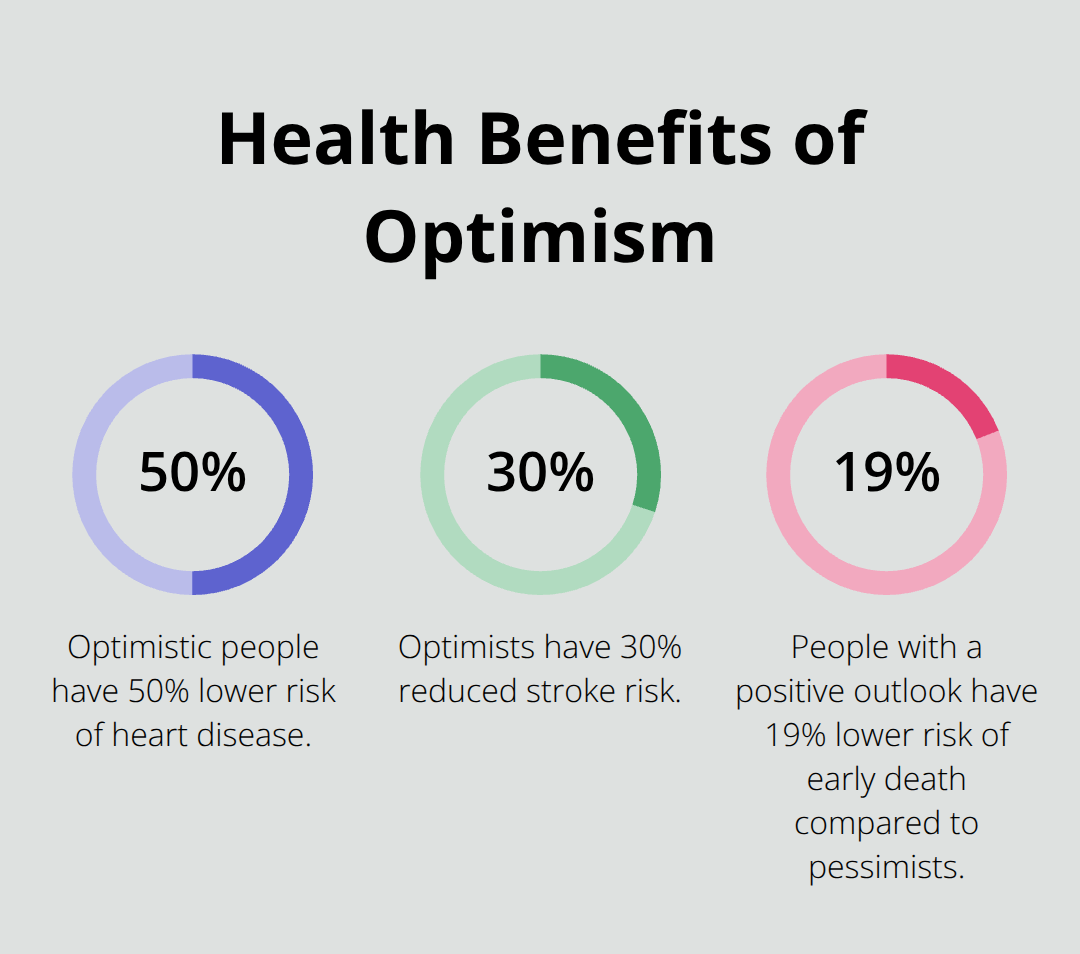Your mindset shapes every moment of your day. Research shows that people who cultivate a positive outlook experience better physical health, stronger relationships, and greater life satisfaction.
We at Global Positive News Network believe that positivity isn’t just wishful thinking-it’s a skill you can develop. The strategies in this guide are backed by neuroscience and proven through real-world application.
What Does Science Actually Say About Positive Thinking
Your brain physically changes when you practice positive thinking. Neuroscientist research reveals that positive thoughts actually change our neural pathways. The brain’s neuroplasticity allows you to strengthen optimistic thought patterns through daily practice, which makes positivity your default response rather than a forced effort. Studies from Harvard Medical School show that people who practice gratitude for just 10 minutes daily develop measurably thicker prefrontal cortex tissue within 8 weeks.
Optimism Extends Your Life by Years
Harvard’s Nurses’ Health Study found that people who had higher levels of optimism had a longer life span. The research shows optimistic people have 50% lower risk of heart disease and 30% reduced stroke risk. Dr. Laura Kubzansky’s work at Harvard School of Public Health demonstrates that positive emotions protect against inflammation markers like IL-6 (which cause cellular damage). Optimists also maintain healthier blood pressure and show stronger immune responses to vaccines.

Mental Health Benefits Start Immediately
The Journal of Happiness Studies published research that positive psychology interventions reduce depression symptoms by 41% within 6 weeks. Participants who wrote down three good things daily showed significant mood improvements after just one week. Dr. Martin Seligman’s research at University of Pennsylvania proves that people who practice optimism techniques increase life satisfaction scores by an average of 25% and maintain these gains for 6 months. The key lies in consistent daily application rather than occasional positive sessions.
Physical Health Improvements You Can Measure
Stanford University research shows that optimistic cardiac patients recover 30% faster from surgery compared to pessimistic patients. Positive thinkers experience lower cortisol levels throughout the day, which reduces chronic inflammation and supports better sleep quality. The American Heart Association found that people with a positive outlook have 19% lower risk of early death compared to pessimists. These measurable changes happen because optimism directly affects your body’s stress response systems.
Now that you understand the scientific foundation, you can apply specific daily habits that transform these research findings into real-world results.
Which Daily Habits Actually Build Lasting Positivity
The University of California Berkeley found that people who write three specific things they appreciate each morning show 25% higher satisfaction scores after just 21 days. Start each day and write down one person who helped you recently, one small moment that brought you joy, and one thing about your health or abilities you value. This practice takes 3 minutes and rewires your brain to notice positive details throughout the day. Research from the Greater Good Science Center shows that gratitude journals increase dopamine production by 23% within the first week (this creates a natural motivation boost that carries through your entire day).
Morning Practices That Change Your Brain Chemistry
Wake up 10 minutes earlier to practice the 3-3-3 technique developed at Stanford Medical Center. Breathe in for 3 counts, hold for 3 counts, exhale for 3 counts, and repeat this cycle 3 times. This activates your parasympathetic nervous system and helps reduce stress levels according to research. Follow this with a 5-minute body scan where you mentally check each part of your body from toes to head and notice areas of comfort rather than tension. Dr. Sara Lazar’s Harvard research proves that just 8 weeks of this practice increases gray matter density in brain regions associated with memory and sense of self.
Physical Movement Creates Instant Mood Shifts
Take a 12-minute walk outside within 2 hours of waking up. Natural light exposure during this window increases serotonin production by 40% and regulates your circadian rhythm for better sleep quality. The American Psychological Association found that people who walk for 12 minutes daily report 16% fewer negative thoughts compared to sedentary individuals. Dance to two upbeat songs while you do household tasks – this combination releases endorphins equivalent to eating a piece of chocolate but with mood benefits that extend 4-6 hours.

Mindfulness Techniques That Work in Real Life
Practice the 5-4-3-2-1 grounding technique when you feel overwhelmed. Name 5 things you can see, 4 things you can touch, 3 things you can hear, 2 things you can smell, and 1 thing you can taste. This anchors you in the present moment and stops negative thought spirals within 90 seconds (according to UCLA’s Mindful Awareness Research Center). Try micro-meditations of just 2 minutes between daily activities – focus on your breath while coffee brews or practice gratitude while you brush your teeth.
These simple habits create the foundation for positivity, but what happens when negative thoughts and challenging emotions threaten to derail your progress?
How Do You Stop Negative Thoughts From Taking Over
Negative thoughts hit everyone, but you can stop them within 30 seconds with the STOP technique that UCLA researchers developed. When you catch yourself spiraling, say STOP out loud, take three deep breaths, observe what triggered the thought without judgment, and pivot to one concrete action you can take right now. Yale School of Medicine found that people who practice this technique reduce rumination time by 67% within two weeks. The key lies in interrupting the thought pattern before it builds momentum-negative thoughts compound exponentially if you let them run for more than 90 seconds.
Transform Negative Situations Into Learning Opportunities
Challenge catastrophic thoughts by asking three specific questions that cognitive behavioral therapists use with patients. First, what evidence supports this negative thought versus evidence against it. Second, what would you tell your best friend if they faced this exact situation. Third, how will this matter in five years from now. Dr. Aaron Beck’s research at University of Pennsylvania shows that people who use these reframing questions reduce anxiety symptoms by 45% after they practice for just three weeks. Write down your answers because the physical act of writing engages different brain regions and makes the reframe more powerful than just thinking through the process.
Cut Off Negative People and Information Sources
Limit conversations with chronic complainers to maximum 10 minutes per interaction. Stanford Research Institute found that exposure to negative people for more than 10 minutes activates stress hormones that stay elevated for hours afterward. Set specific times to check news-once at 9am and once at 6pm for no more than 15 minutes each session. Psychologist Dr. Graham Davey at University of Sussex proved that people who consume negative news for more than 30 minutes daily show 27% higher anxiety levels and sleep 40 minutes less per night (this creates a cascade of negative effects on both mental and physical health). Replace doom-scrolling with solution-focused content that shows people solving problems rather than just highlighting what’s wrong.

Build Mental Resilience Through Stress Management
Practice the 4-7-8 breathing technique when stress levels spike. Inhale for 4 counts, hold your breath for 7 counts, then exhale for 8 counts. This technique activates your vagus nerve and can help manage stress responses. Create a “worry window”-set aside 15 minutes daily at the same time to write down all your concerns, then close the notebook and refuse to engage with those thoughts outside this designated time. Harvard Medical School research demonstrates that people who use worry windows experience 38% less anxiety throughout the day compared to those who let worries surface randomly.
Final Thoughts
The research proves that when you cultivate a positive outlook, you literally rewire your brain for better health and happiness. The three-minute gratitude practice, 12-minute daily walks, and STOP technique for negative thoughts create measurable changes in your neural pathways within weeks. Harvard studies show these simple habits reduce heart disease risk by 50% and extend lifespan significantly.
Start with just one technique tomorrow morning. Write down three things you appreciate, practice the 4-7-8 breath method, or take that 12-minute walk outside. Small consistent actions compound into life-changing results over months and years (your brain adapts faster than most people realize).
Your positive mindset affects everyone around you through emotional contagion. When you maintain optimism, you create ripple effects that improve your relationships, work performance, and overall life satisfaction. We at Global Positive News Network provide inspiring stories and positive perspectives that help sustain your optimistic outlook long-term. The science is clear: positivity works when you practice it consistently.




